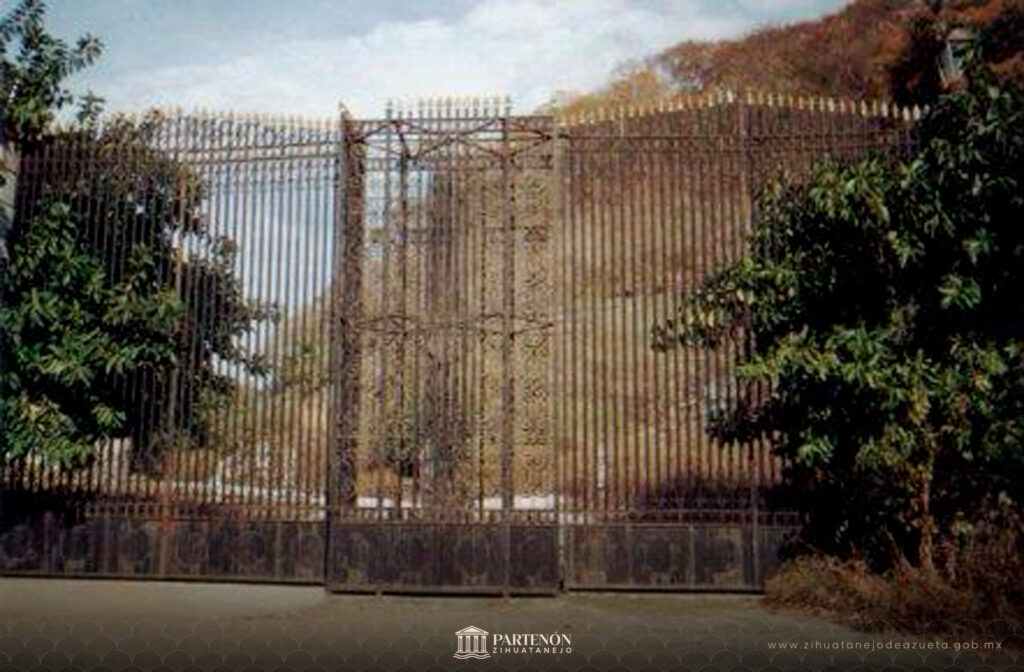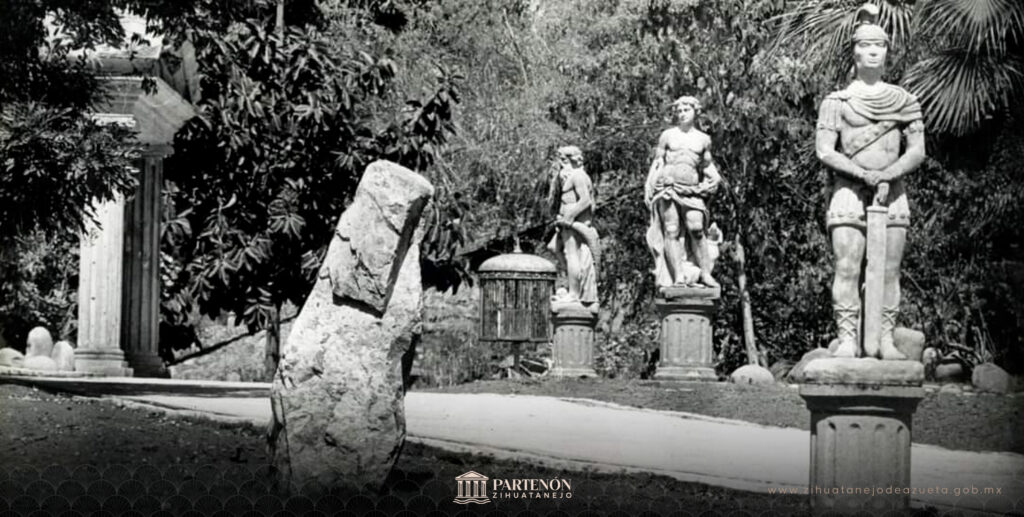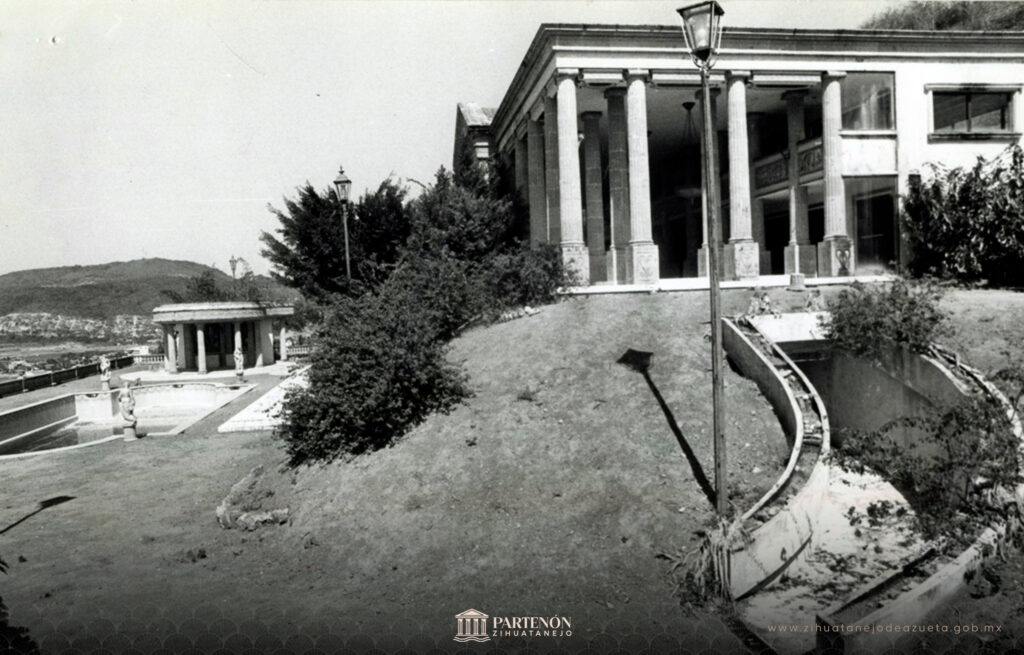History
The Parthenon is a building from the late 1970s built by the former Chief of Police of Mexico City, Arturo «El Negro» Durazo. It was constructed in the center of Zihuatanejo Bay, very close to La Ropa Beach, Zihuatanejo, with an unparalleled view. It was built on 20,000 square meters and had an approximate cost of 700 million pesos. In reality, the mansion was very little used as it fell into disrepair starting in 1982.
Upon entering the property, you are greeted by a wrought iron gate measuring 15 meters wide by 10 meters high. It resembles the entrance to the official residence of Los Pinos, although it is said that it could be the same one that originally stood at Chapultepec Castle.
A warehouse was placed next to the main gate, where there was also a cage for wild animals such as lions and tigers, exotic pets of the then police chief.
The white marble statues, replicas of David, Apollo, nymphs, and Doric warriors with Spartan helmets, are imposing. They were the first glimpse anyone had of this unique Olympus. The Greco-Roman style residence, supported by 57 enormous columns, quarry walls and marble floors, also had walls full of decorations, paintings, a nightclub and a swimming pool.
The Parthenon was valued at $30 million and featured amenities such as an exclusive nightclub that was a replica of Studio 54, a famous New York nightclub from the late 1970s.
The property’s decor was ostentatious, with murals and wall decorations featuring Greco-Roman elements that made this mansion unique. On the second floor, there was a living room and four bedrooms, fine wood furniture with luxurious finishes, mirrored ceilings, and hanging beds.
The main hallway housed the living and dining rooms, in which there was a large single-piece green marble table. In the center of the room was a bronze sculpture of a satyr, the work of Italian artist Adolfo Octavio Ponzanelli, who also created several marble sculptures located throughout the mansion.
Many stories are told about tunnels that once existed within the mansion. Currently, only a few small passages for serving the old pool remain, but they are neither suitable nor safe for access. The legend of a tunnel that once reached La Ropa Beach has also been widely known. However, it no longer exists; it has been sealed off, and its original route has been forgotten.
Based on experience, knowledge and official documentation, Mr. Rodrigo Campos Aburto, Chronicler of the Zihuatanejo City, relates the following:
“Many legends have been written about the construction located on top of one of the hills surrounding Zihuatanejo Bay in the Playa La Ropa area, which was commissioned by Arturo Durazo Moreno when he was Police Director in Mexico City, during the Government of the President of Mexico, Mr. José López Portillo (1976-1982), a construction which was called THE PARTHENON.
Making history, the land where this building is located has an area of approximately 10,000 square meters and was originally part of the Zihuatanejo Ejido. It consisted of land owned by Mr. Raúl Pérez Anaya, Mr. Gumesindo García Martínez, Mr. Luis Moreno Labastida, and Mr. José Solórzano, when part of that Ejido was expropriated by the Federal Government to establish a Trust so-called the Zihuatanejo Bay Trust (FIBAZI).
On December 1976, the owners of this land transferred the rights of possession to Arturo Durazo Moreno and Silvia Garza Sáenz de Durazo, who were recognized before FIBAZI as owners of that property, and on July 28, 1980, an agreement was signed between Arch. Raúl Esponda Rodríguez, then Director of FIBAZI, and Arturo Durazo Moreno, with this agreement, the start of construction of a house on the land was allowed.
For the construction of this project, in late 1980, the City Council granted Mr. Durazo a construction permit, which was issued tax-exempt, considering «the services» he provided to the community.
At the beginning of President Miguel de la Madrid’s administration, the fall of Arturo Durazo began. When Durazo was persecuted and imprisoned, the mansion was abandoned, suffering looting of art and fine accessories that were found there.
The work in the main building has two floors and a basement, a dining room and hall room where there are around thirty Ionic columns; upstairs there were four bedrooms and a study, and downstairs there was also a kitchen and library. The terrace had electric curtains. At the back of the mansion were gardens and a cage said to house a lion. Outside, there was a parking lot, and to one side of the house was the entrance to a tunnel that crossed the property and the street to open onto a plot of land purchased from Mr. Tomás Zúñiga Mendoza. This land was intended to serve as a heliport but was never built.
Some years passed and that majestic building began to deteriorate little by little, it’s exterior and interior walls, bedrooms and all the mansion, some sculptures were damaged, the main one was a bronze faun, work of the Italian sculptor Ponzanelli, it was stolen from the mansion, currently its location is unknown, the paintings were graffitied, the bathrooms without furniture, the gardens full of weeds and the pool in full deterioration, the only splendorous thing is the view of the bay that from the terrace can be fully appreciated without any visual obstacle, its structure and roof are in good condition, as well as the main gate, which was said to have been stolen from the Chapultepec Zoo in Mexico City, which is perhaps just an urban legend.
At the beginning of 1989, Mr. Jorge Allec Galeana, who was President of the Municipal Committee of the PRI Political Party, organized a symbolic takeover of that property, accompanied by the then Municipal President Gabino Fernández and a group of officials and residents of our Municipality and under the argument that this property belonged to the people, it was requested that it be expropriated for the benefit of the community and that was how the Governor of the State, José Francisco Ruiz Massieu, issued an expropriation decree for the El Partenón property, stating in Article 1 of said decree published in the Official State Gazette No. 73 of August 29, 1989, the following:
“Art. 1.- The construction of works and the expansion and rehabilitation of existing works on the surface identified in the recitals of this decree are hereby declared to be of public utility for the formation of a multipurpose social unit that will provide services for conventions, exhibitions, training and instruction, business development, cultural and recreational activities, and other similar activities.”
But during the rest of the government period of José Francisco Ruiz Massieu (1987-1993), neither in that of Figueroa Alcocer, Ángel Aguirre Rivero (1993-1999) and René Juárez Cisneros (1999-2005), the purpose of the expropriation was fulfilled.
Since the works for which the expropriation was decreed were not carried out within the 5-year period established by the State Expropriation Law, the legal figure called «reversion» would have operated, which consisted of the property subject to expropriation returning to the assets of the affected owners. In 2004, after the death of Mr. Arturo Durazo Moreno and Mrs. Silvia Garza Sáenz de Durazo, the executor of the estates of these persons, Francisco Arturo Durazo Garza, requested the Governor of the State of Guerrero, René Juárez Cisneros, to decree the reversion of that expropriation.
Since the works for which the expropriation was decreed were not carried out within the 5-year period established by the State Expropriation Law, the legal figure called «reversion» would have operated, which consisted of the property subject to expropriation returning to the assets of the affected owners. In 2004, after the death of Mr. Arturo Durazo Moreno and Mrs. Silvia Garza Sáenz de Durazo, the executor of the estates of these persons, Francisco Arturo Durazo Garza, requested the Governor of the State of Guerrero, René Juárez Cisneros, to decree the reversion of that expropriation. This request was denied, so the executor filed a lawsuit before the Regional Chamber in Zihuatanejo of the State Administrative Litigation Court, in which he demanded the annulment of the State Government’s refusal to decree said reversion, a Court that ruled against the plaintiff’s interests, the lawsuit reached the Supreme Court of Justice of the Nation, which ruled definitively in favor of the State Government, which must proceed to comply with the expropriation decree.
To the delight of the residents of Zihuatanejo, on August 5, 2022, in an emotional event held at the El Partenón facilities, a loan for use agreement was signed between the Government of the Guerrero State as lender and the Zihuatanejo City Council as borrower, with the participation of Mtra. Evelyn Salgado Pineda, Governor of our State, as an honorary witness. The agreement was signed by the Guerrero Tourism Promoter, its head, Mr. José Luis González de la Vega Otero, and by the Government of Zihuatanejo, the Mayor Mr. Jorge Sánchez Allec.
At this event, it was announced that the Zihuatanejo City Council would be responsible for the operation and management of El Partenón, which would be remodeled with support from the State and Municipal Governments, and finally return the property to the use for which it was expropriated. Work began on its renovation, including paving the access road leading to the venue.
Once the renovation work was completed, the inauguration of the venue was held on November 6, 2024. The ceremony was led by Ms. Evelyn Salgado Pineda, Governor of Guerrero State, and C.P. Lizette Tapia Castro, Mayor of Zihuatanejo; and the former Mayor Jorge Sánchez Allec attended as a guest of honor, who was a determined promoter of the renovation of the venue.
An event celebrated by all attendees, and the community was very pleased with the change of use of the property. Zihuatanejo now has a place that will be a symbol of the port. Although the origin of this mansion was arrogance and the illegal use of public resources, now with a new purpose the building will continue to be called El Partenón, but will be identified as a place for the development of arts and culture. A construction created under the guidelines of the mind of a powerful official, who without any scruples had dreamed of emulating some ancient Greek ruler having at his feet the splendid view of the Zihuatanejo Bay, and that due to the wise decision of government wills, today the people of Zihuatanejo can boast of this splendid mansion as a venue for cultural activities for the benefit of both local residents and national and foreign visitors.”… expressed Mr. Rodrigo Campos Aburto, Chronicler of the Zihuatanejo City.
In 1982, as a result of the «Moral Renewal» campaign of then-new Mexican President Miguel de la Madrid, «El Negro» became one of the figures targeted by the institutional cleaning. Interpol arrested him on May 31, 1984, at the San Juan, Puerto Rico International Airport, and two years later, he was deported to Mexico, where he was accused of extortion, arms stockpiling, tax evasion, multiple homicide, and illicit enrichment. He remained in prison for five years despite his 16-year sentence, and lived out his final years in Acapulco, where he died on August 5, 2000.
Despite the deterioration caused by more than 40 years of neglect and after five state administrations, nothing concrete had been achieved regarding the property. It was during the administrations of Evelyn Cecia Salgado Pineda, Governor of the Guerrero State (2021-2027), and Jorge Sánchez Allec, Mayor of Zihuatanejo (2018-2024), that the property rights were obtained from the State Government, and in turn, a loan agreement was signed to create a unique new Cultural and Tourism Center that host major exhibitions, workshops, plays, concerts, and cultural and tourism events.
On November 6, 2024, the El Partenón Zihuatanejo Cultural and Tourist Center was officially inaugurated, headed by Mtra. Evelyn Cecia Salgado Pineda, Constitutional Governor of the Guerrero State, the Mayor of Zihuatanejo, C.P. Lizette Tapia Castro and the Former Mayor of Zihuatanejo, Lic. Jorge Sánchez Allec, who accompanied by state and municipal authorities, representatives of the tourism industry, local businessmen and the general public, witnessed the beginning of a new stage for this venue, which becomes and positions itself as an unmissable tourist attraction when visiting Ixtapa Zihuatanejo.
.





